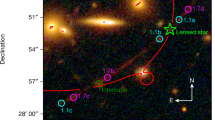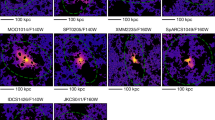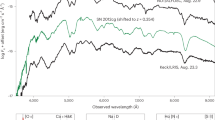Abstract
Galaxy-cluster gravitational lenses can magnify background galaxies by a total factor of up to ~50. Here we report an image of an individual star at redshift z = 1.49 (dubbed MACS J1149 Lensed Star 1) magnified by more than ×2,000. A separate image, detected briefly 0.26″ from Lensed Star 1, is probably a counterimage of the first star demagnified for multiple years by an object of ≳3 solar masses in the cluster. For reasonable assumptions about the lensing system, microlensing fluctuations in the stars’ light curves can yield evidence about the mass function of intracluster stars and compact objects, including binary fractions and specific stellar evolution and supernova models. Dark-matter subhaloes or massive compact objects may help to account for the two images’ long-term brightness ratio.
This is a preview of subscription content, access via your institution
Access options
Access Nature and 54 other Nature Portfolio journals
Get Nature+, our best-value online-access subscription
$29.99 / 30 days
cancel any time
Subscribe to this journal
Receive 12 digital issues and online access to articles
$119.00 per year
only $9.92 per issue
Buy this article
- Purchase on Springer Link
- Instant access to full article PDF
Prices may be subject to local taxes which are calculated during checkout





Similar content being viewed by others
References
Miralda-Escude, J. The magnification of stars crossing a caustic. I—Lenses with smooth potentials. Astrophys. J. 379, 94–98 (1991).
Kelly, P. L. et al. Multiple images of a highly magnified supernova formed by an early-type cluster galaxy lens. Science 347, 1123–1126 (2015).
Rodney, S. A. et al. SN Refsdal: photometry and time delay measurements of the first Einstein cross supernova. Astrophys. J. 820, 50 (2016).
Kelly, P. L. et al. Deja vu all over again: the reappearance of supernova Refsdal. Astrophys. J. Lett. 819, L8 (2016).
Oguri, M. Predicted properties of multiple images of the strongly lensed supernova SN Refsdal. Mon. Not. R. Astron. Soc. 449, L86–L89 (2015).
Sharon, K. & Johnson, T. L. Revised lens model for the multiply imaged lensed supernova, SN Refsdal in MACS J1149+2223. Astrophys. J. Lett. 800, L26 (2015).
Diego, J. M. et al. A free-form prediction for the reappearance of supernova Refsdal in the Hubble Frontier Fields cluster MACSJ1149.5+2223. Mon. Not. R. Astron. Soc. 456, 356–365 (2016).
Jauzac, M. et al. Hubble Frontier Fields: predictions for the return of SN Refsdal with the MUSE and GMOS spectrographs. Mon. Not. R. Astron. Soc. 457, 2029–2042 (2016).
Grillo, C. et al. The story of supernova ‘Refsdal’ told by MUSE. Astrophys. J. 822, 78 (2016).
Kawamata, R., Oguri, M., Ishigaki, M., Shimasaku, K. & Ouchi, M. Precise strong lensing mass modeling of four Hubble Frontier Field clusters and a sample of magnified high-redshift galaxies. Astrophys. J. 819, 114 (2016).
Treu, T. et al. ‘Refsdal’ meets Popper: comparing predictions of the re-appearance of the multiply imaged supernova behind MACSJ1149.5+2223. Astrophys. J. 817, 60 (2016).
Ebeling, H. et al. A complete sample of 12 very X-ray luminous galaxy clusters at z > 0.5. Astrophys. J. Lett. 661, L33–L36 (2007).
Smith, G. P. et al. Hubble Space Telescope observations of a spectacular new strong-lensing galaxy cluster: MACS J1149.5+2223 at z=0.544. Astrophys. J. Lett. 707, L163–L168 (2009).
Zitrin, A. & Broadhurst, T. Discovery of the largest known lensed images formed by a critically convergent lensing cluster. Astrophys. J. Lett. 703, L132–L136 (2009).
Yuan, T.-T., Kewley, L. J., Swinbank, A. M., Richard, J. & Livermore, R. C. Metallicity gradient of a lensed face-on spiral galaxy at redshift 1.49. Astrophys. J. Lett. 732, L14 (2011).
Karman, W. et al. Highly ionized region surrounding SN Refsdal revealed by MUSE. Astron. Astrophys. 585, A27 (2016).
Castelli, F. & Kurucz, R. L. New grids of ATLAS9 model atmospheres. Preprint at https://arxiv.org/abs/astro-ph/0405087 (2004).
Diego, J. M. et al. Dark matter under the microscope: constraining compact dark matter with caustic crossing events. Preprint at https://arxiv.org/abs/1706.10281 (2017).
Dachs, J. Photometry of bright stars in the Small Magellanic Cloud. Astron. Astrophys. 9, 95–109 (1970).
Bresolin, F. et al. A Hubble Space Telescope study of extragalactic OB associations. Astron. J. 116, 119–130 (1998).
Xu, B. et al. The detection and statistics of giant arcs behind CLASH clusters. Astrophys. J. 817, 85 (2016).
Duchêne, G. & Kraus, A. Stellar multiplicity. Ann. Rev. Astron. Astr. 51, 269–310 (2013).
Woosley, S. E., Heger, A. & Weaver, T. A. The evolution and explosion of massive stars. Rev. Mod. Phys. 74, 1015–1071 (2002).
Fryer, C. L. et al. Compact remnant mass function: dependence on the explosion mechanism and metallicity. Astrophys. J. 749, 91 (2012).
Spera, M., Mapelli, M. & Bressan, A. The mass spectrum of compact remnants from the PARSEC stellar evolution tracks. Mon. Not. R. Astron. Soc. 451, 4086–4103 (2015).
Bird, S. et al. Did LIGO detect dark matter? Phys. Rev. Lett. 116, 201301 (2016).
Lotz, J. M. et al. The Frontier Fields: survey design and initial results. Astrophys. J. 837, 97 (2017).
Jones, D. O., Scolnic, D. M. & Rodney, S. A. PythonPhot: simple DAOPHOT-type photometry in Python ascl:1501.010 (Astrophysics Source Code Library, 2015).
Rodney, S. A. et al. Illuminating a dark lens: a type Ia supernova magnified by the Frontier Fields galaxy cluster Abell 2744. Astrophys. J. 811, 70 (2015).
Conroy, C., Gunn, J. E. & White, M. The propagation of uncertainties in stellar population synthesis modeling. I. The relevance of uncertain aspects of stellar evolution and the initial mass function to the derived physical properties of galaxies. Astrophys. J. 699, 486–506 (2009).
Conroy, C. & Gunn, J. E. The propagation of uncertainties in stellar population synthesis modeling. III. Model calibration, comparison, and evaluation. Astrophys. J. 712, 833–857 (2010).
Kroupa, P. On the variation of the initial mass function. Mon. Not. R. Astron. Soc. 322, 231–246 (2001).
Cardelli, J. A., Clayton, G. C. & Mathis, J. S. The relationship between infrared, optical, and ultraviolet extinction. Astrophys. J. 345, 245–256 (1989).
Marigo, P. & Girardi, L. Evolution of asymptotic giant branch stars. I. Updated synthetic TP-AGB models and their basic calibration. Astron. Astrophys. 469, 239–263 (2007).
Marigo, P. et al. Evolution of asymptotic giant branch stars. II. Optical to far-infrared isochrones with improved TP-AGB models. Astron. Astrophys. 482, 883–905 (2008).
Asplund, M., Grevesse, N., Sauval, A. J. & Scott, P. The chemical composition of the Sun. Ann. Rev. Astron. Astr. 47, 481–522 (2009).
Foreman-Mackey, D., Hogg, D. W., Lang, D. & Goodman, J. emcee: the MCMC hammer. Publ. Astron. Soc. Pac. 125, 306–312 (2013).
Dolphin, A. E. WFPC2 stellar photometry with HSTPHOT. Publ. Astron. Soc. Pac. 112, 1383–1396 (2000).
Watson, W. A. et al. The halo mass function through the cosmic ages. Mon. Not. R. Astron. Soc. 433, 1230–1245 (2013).
Zitrin, A. et al. Hubble Space Telescope combined strong and weak lensing analysis of the CLASH sample: mass and magnification models and systematic uncertainties. Astrophys. J. 801, 44 (2015).
Zitrin, A. et al. New multiply-lensed galaxies identified in ACS/NIC3 observations of Cl0024+1654 using an improved mass model. Mon. Not. R. Astron. Soc. 396, 1985–2002 (2009).
Oguri, M. The mass distribution of SDSS J1004+4112 revisited. Publ. Astron. Soc. Jpn 62, 1017–1024 (2010).
Jullo, E. et al. A Bayesian approach to strong lensing modelling of galaxy clusters. New. J. Phys. 9, 447 (2007).
Suyu, S. H. & Halkola, A. The halos of satellite galaxies: the companion of the massive elliptical lens SL2S J08544-0121. Astron. Astrophys. 524, A94 (2010).
Suyu, S. H. et al. Disentangling baryons and dark matter in the spiral gravitational lens B1933+503. Astrophys. J. 750, 10 (2012).
Schmidt, K. B. et al. Through the looking GLASS: HST spectroscopy of faint galaxies lensed by the Frontier Fields cluster MACSJ0717.5+3745. Astrophys. J. Lett. 782, L36 (2014).
Treu, T. et al. The Grism Lens-Amplified Survey from Space (GLASS). I. Survey overview and first data release. Astrophys. J. 812, 114 (2015).
Kelly, P. L. et al. SN Refsdal: classification as a luminous and blue SN 1987A-like type II supernova. Astrophys. J. 831, 205 (2016).
Chabrier, G. The galactic disk mass function: reconciliation of the Hubble Space Telescope and nearby determinations. Astrophys. J. Lett. 586, L133–L136 (2003).
Gaudi, B. S. & Petters, A. O. Gravitational microlensing near caustics. I. Folds. Astrophys. J. 574, 970–984 (2002).
Treu, T. et al. The initial mass function of early-type galaxies. Astrophys. J. 709, 1195–1202 (2010).
Auger, M. W. et al. Dark matter contraction and the stellar content of massive early-type galaxies: disfavoring ‘light’ initial mass functions. Astrophys. J. Lett. 721, L163–L167 (2010).
Spiniello, C., Koopmans, L. V. E., Trager, S. C., Czoske, O. & Treu, T. The X-Shooter Lens Survey—I. dark matter domination and a Salpeter-type initial mass function in a massive early-type galaxy. Mon. Not. R. Astron. Soc. 417, 3000–3009 (2011).
Cappellari, M. et al. Systematic variation of the stellar initial mass function in early-type galaxies. Nature 484, 485–488 (2012).
van Dokkum, P. G. & Conroy, C. A substantial population of low-mass stars in luminous elliptical galaxies. Nature 468, 940–942 (2010).
Conroy, C. & van Dokkum, P. G. The stellar initial mass function in early-type galaxies from absorption line spectroscopy. II. Results. Astrophys. J. 760, 71 (2012).
Newman, A. B., Smith, R. J., Conroy, C., Villaume, A. & van Dokkum, P. The initial mass function in the nearest strong lenses from SNELLS: assessing the consistency of lensing, dynamical, and spectroscopic constraints. Astrophys. J. 845, 157 (2017).
Barnabè, M. et al. A low-mass cut-off near the hydrogen burning limit for Salpeter-like initial mass functions in early-type galaxies. Mon. Not. R. Astron. Soc. 436, 253–258 (2013).
Conroy, C., van Dokkum, P. G. & Villaume, A. The stellar initial mass function in early-type galaxies from absorption line spectroscopy. IV. A super-Salpeter IMF in the center of NGC 1407 from non-parametric models. Astrophys. J. 837, 166 (2017).
Alves de Oliveira, C. et al. Spectroscopy of brown dwarf candidates in IC 348 and the determination of its substellar IMF down to planetary masses. Astron. Astrophys. 549, A123 (2013).
Moraux, E., Bouvier, J., Stauffer, J. R. & Cuillandre, J.-C. Brown dwarfs in the Pleiades cluster: clues to the substellar mass function. Astron. Astrophys. 400, 891–902 (2003).
Renzini, A. & Ciotti, L. Transverse dissections of the fundamental planes of elliptical galaxies and clusters of galaxies. Astrophys. J. Lett. 416, L49 (1993).
Edwards, L. O. V., Alpert, H. S., Trierweiler, I. L., Abraham, T. & Beizer, V. G. Stellar populations of BCGs, close companions and intracluster light in Abell 85, Abell 2457 and IIZw108. Mon. Not. R. Astron. Soc. 461, 230–239 (2016).
Smartt, S. J., Eldridge, J. J., Crockett, R. M. & Maund, J. R. The death of massive stars—I. observational constraints on the progenitors of type II-P supernovae. Mon. Not. R. Astron. Soc. 395, 1409–1437 (2009).
Gerke, J. R., Kochanek, C. S. & Stanek, K. Z. The search for failed supernovae with the Large Binocular Telescope: first candidates. Mon. Not. R. Astron. Soc. 450, 3289–3305 (2015).
Pejcha, O. & Thompson, T. A. The landscape of the neutrino mechanism of core-collapse supernovae: neutron star and black hole mass functions, explosion energies, and nickel yields. Astrophys. J. 801, 90 (2015).
Hamann, W.-R., Schoenberner, D. & Heber, U. Mass loss from extreme helium stars. Astron. Astrophys. 116, 273–285 (1982).
Hamann, W.-R. & Koesterke, L. Spectrum formation in clumped stellar winds: consequences for the analyses of Wolf-Rayet spectra. Astron. Astrophys. 335, 1003–1008 (1998).
Smith, N. Mass loss: its effect on the evolution and fate of high-mass stars. Ann. Rev. Astron. Astr. 52, 487–528 (2014).
Belczynski, K. et al. Compact object modeling with the StarTrack population synthesis code. Astrophys. J. Suppl. S. 174, 223–260 (2008).
Belczynski, K. et al. On the maximum mass of stellar black holes. Astrophys. J. 714, 1217–1226 (2010).
Sana, H. et al. Binary interaction dominates the evolution of massive stars. Science 337, 444 (2012).
Sharon, K. et al. The type Ia supernova rate in redshift 0.5–0.9 galaxy clusters. Astrophys. J. 718, 876–893 (2010).
Postman, M. et al. The Cluster Lensing and Supernova survey with Hubble: an overview. Astrophys. J. Suppl. S. 199, 25 (2012).
Graur, O. et al. Type-Ia supernova rates to redshift 2.4 from CLASH: The Cluster Lensing and Supernova survey with Hubble. Astrophys. J. 783, 28 (2014).
Keeton, C. R. On modeling galaxy-scale strong lens systems. Gen. Rel. Grav. 42, 2151–2176 (2010).
Acknowledgements
We thank the directors of the Space Telescope Science Institute, the Gemini Observatory, the GTC and the European Southern Observatory for granting us discretionary time. We thank B. Katz, D. Kushnir, B. Periello, I. Momcheva, T. Royale, L. Strolger, D. Coe, J. Lotz, M. L. Graham, R. Humphreys, R. Kurucz, A. Dolphin, M. Kriek, S. Rajendran, T. Davis, I. Hubeny, C. Leitherer, F. Nieva, D. Kasen, J. Mauerhan, D. Kelson, J. M. Silverman, A. Oscoz Abaz and Z. Levay for help with the observations and other assistance. The Keck Observatory was made possible with the support of the W. M. Keck Foundation. NASA/STScI grants 14041, 14199, 14208, 14528, 14872 and 14922 provided financial support. P.L.K., A.V.F. and W.Z. are grateful for assistance from the Christopher R. Redlich Fund, the TABASGO Foundation and the Miller Institute for Basic Research in Science (U. C. Berkeley). The work of A.V.F. was completed in part at the Aspen Center for Physics, which is supported by NSF grant PHY-1607611. J.M.D. acknowledges support of projects AYA2015-64508-P (MINECO/FEDER, UE) and AYA2012-39475-C02-01 and the consolider project CSD2010-00064 funded by the Ministerio de Economia y Competitividad. P.G.P.-G. acknowledges support from Spanish government MINECO grants AYA2015-70815-ERC and AYA2015-63650-P. M.O. is supported by JSPS KAKENHI grants 26800093 and 15H05892. M.J. acknowledges support by the Science and Technology Facilities Council (grant ST/L00075X/1). R.J.F. is supported by NSF grant AST-1518052 and Sloan and Packard Foundation fellowships. M.N. acknowledges support from PRIN-INAF-2014 1.05.01.94.02. O.G. was supported by NSF Fellowship under award AST-1602595. J.H. acknowledges support from a VILLUM FONDEN Investigator Grant (16599). HST imaging was obtained at https://archive.stsci.edu.
Author information
Authors and Affiliations
Contributions
P.L.K. planned and analysed observations, wrote the manuscript and developed simulations. P.L.K., S.R., P.G.P.-G., T.Ma., M.J., J.S., A.V.F., J.H., D.A.H., S.B.C., B.L.F., M.B., W.Z., G.B., A.M.B., A.C., L.C., C.G., J.-P.K., T.Mo., C.M., M.N., I.P.-F., A.G.R., P.R., K.B.S. and B.J.W. obtained follow-up HST and ground-based imaging. J.M.D. developed microlensing simulations. S.R., T.B., A.Z., T.T., P.G.P.-G., M.J., M.O., A.V.F., N.S., J.H., B.L.F. and S.E.d.M. helped to prepare the manuscript. N.K. interpreted the microlensing events and derived analytic rate formula. T.B., A.Z., T.T., M.J., M.O., X.W., S.W.J., R.J.F., S.E.d.M., O.G. and B.J.W. aided the interpretation. P.G.P.-G. modelled the arc’s SED. T.Mo. modelled the ICL. M.O., J.R., R.K. and K.S. modelled the galaxy cluster. L.P. and C.N. considered the possibility that Icarus could exhibit diffraction effects. T.W.R. analysed the microlensing simulations. N.S. aided interpretation of the star’s SED. X.W. estimated the gas-phase metallicity at Icarus’s location. M.N. extracted photometry of Icarus using a complementary pipeline.
Corresponding author
Ethics declarations
Competing interests
The authors declare no competing interests.
Additional information
Publisher’s note: Springer Nature remains neutral with regard to jurisdictional claims in published maps and institutional affiliations.
Supplementary information
Supplementary Information
Supplementary Figures 1–14, Supplementary Tables 1–4, Supplementary References 1–35 and Supplementary Text.
Rights and permissions
About this article
Cite this article
Kelly, P.L., Diego, J.M., Rodney, S. et al. Extreme magnification of an individual star at redshift 1.5 by a galaxy-cluster lens. Nat Astron 2, 334–342 (2018). https://doi.org/10.1038/s41550-018-0430-3
Received:
Accepted:
Published:
Issue Date:
DOI: https://doi.org/10.1038/s41550-018-0430-3
This article is cited by
-
Searching for Strong Gravitational Lenses
Space Science Reviews (2024)
-
A star from the dawn of the Universe
Nature Astronomy (2022)
-
A highly magnified star at redshift 6.2
Nature (2022)
-
Cosmic flashing lights
Nature Astronomy (2018)



